JAMIE CHAN
— It is in homage to the artist Bernice Bing that I share the following photographs of parts of paintings I’ve made over the last 10 years, which no longer exist because I painted over or destroyed them.
Bernice Bing (1936-1998) was an abstract expressionist painter in the Bay Area who participated in the art world alongside people like Joan Brown, Richard Diebenkorn, Wally Hedrick, Carlos Villa, Jay de Feo. Unlike myself, she even had teachers who were of Asian descent, including the zen master painter, Saburo Hasegawa. Her ambitious work is large, gnarly and physical, but subtle and commodious, and expands upon American abstract painting, considering calligraphy, landscape, and spirituality. She was among the first residents at Esalen Institute! In the 60s and 70s she organized neighborhood art programs in Chinatown, including work with youths involved in Chinese gangs which were violent at that time. She said it was the first time she felt re-immersed in Chinese culture since her childhood, and she continued in this work into her late 40s. By all accounts, it exhausted her.
I see her work as held hostage by the needs and taste of two communities who had little awareness of or interest in each other. White authorities and artists perceived of her as an activist and “member” of the Chinese community, a group whose specific cultural commitments, in turn, forced her to neglect her own work at crucial periods. She was left out of larger conversations about painting, while those who knew her hallowly recount her commitment to painting, her courage, her complexity.
In thinking about the photographs I had taken of paintings now “lost,” I’ve been reflecting on the labor that goes into painting… material processes, creative phases, decision making, as well as all the surrounding activities in life that are needed to support the work of painting. Also on a larger scale, the networks of people and communities that contribute to the production of painting. These photographs represent the temporal flux of working in the studio over the years. As I reflect on my process and ways to move ahead in my work, it makes me think about Bernice Bing, and how historical, social and economic conditions (and her reactions to them) have shaped her legacy. What evaporated off, and what was distilled?














—
Jamie Chan was born in Pittsburgh, PA in 1984. She currently lives and works in Brooklyn. She attended Bard College and before that UCLA. Her work adopts the allegorical spaces of Renaissance painting, plumbing art history with an inverted telescope.
